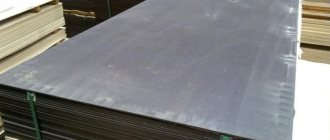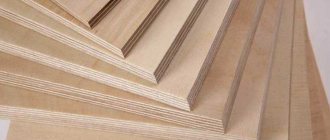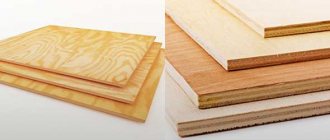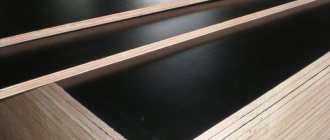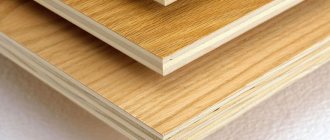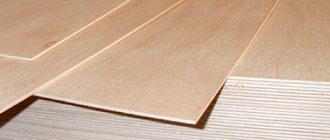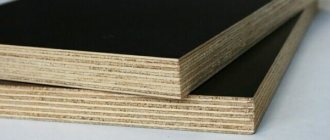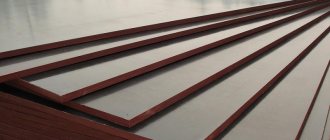What kind of raw material is FSF plywood?
The brand abbreviation FSF stands for “plywood and resin phenol-formaldehyde glue.” It has an increased level of moisture resistance: it can be used for cladding indoor and outdoor spaces. Although, due to phenol emissions, some experts do not recommend it for interior decoration. The material is produced from peeled veneer of coniferous or birch raw materials. Finished sheets are obtained by gluing 3 or more layers.
Distinctive properties of the FSF brand:
- high impact resistance;
- resistance to mechanical damage;
- ease of installation;
- elasticity;
- moisture resistance.
This brand of plywood is often used as a base for laying parquet and laminated floors. Sheets can be impregnated with compounds against moisture and fire (FSF TV). The material has a wide range of applications (from construction to aircraft manufacturing).
Types and markings
Based on the number of layers, it is divided into three basic categories and is:
- multilayer;
- five-layer;
- three-layer.
In general, the sheets contain an odd number of layers so that the veneer runs symmetrically around the middle (the same number comes out on both sides). If their total is even, then the central layers are connected perpendicular to those that run along the outer edges. This adds resistance to deformation and abrasion to the material, as its density increases.
There is another type of separation of sheets: according to the degree of moisture exposure. Having received proper impregnation, they withstand a humid environment even better. Laminated plywood, which literally “rolls” into the laminate, has this property to the maximum, which is why it also becomes flame retardant.
According to the type of surface treatment, FSF can be: polished on both sides (marking Ш2), polished only on one side (marking Ш1) and unpolished (marking Ш).
What is the difference between FC and FSF plywood?
Both brands are variants of one of the most common, durable and affordable building materials. FC and FSF are not inferior to each other in popularity. In terms of convenience and practicality, they have no equal: suitable for ceilings and floors, walls and partitions. They can serve as the basis for any design decisions.
FC birch plywood, oak veneered Source veneer-by.com
If we are talking about FC plywood, what it is and how it differs from FSF, you should pay attention to the composition of the raw materials and glue. First, let's look at the abbreviations:
- FSF - sheets are made by joining veneer with phenol-formaldehyde substances, therefore “plywood and resin phenol-formaldehyde glue”;
- FC is a wood-layer mixture glued with urea-formaldehyde adhesive, abbreviated as “plywood urea-formaldehyde glue.”
The FK brand of plywood is produced from alder or birch veneer (sometimes they are combined). Therefore, FC stands for plywood urea-formaldehyde glue.
This material is characterized by a high level of moisture resistance and a long service life, therefore it is often used as a base for parquet and laminated boards, for wall cladding. FC slabs are also produced up to 40 mm thick, classified depending on the presence of defects on the surface. Birch plywood of this brand is used mainly for interior finishing. FC plywood is considered a budget option and is actively used in construction.
Important!!! When drying after strong moisture, FC slabs may curl or delaminate.
FSF and FC plywood: similarities and differences
Both types of material have similar properties and a wide range of applications. Unlike FSF, a different type of glue is used in the production of FC - urea. This material is a glued veneer. FC plywood is distinguished by its versatility, which is due to the strength of the sheets. The material acquired this property due to the arrangement of the fibers - at an angle to each other, most often perpendicular. FC plywood is moisture resistant. Despite this, it is used mainly for interior decoration, for example, as a base for laminate or parquet. This is due to the absence of phenol in the composition. FC sheets refer to budget materials.
Important: After prolonged contact with moisture, FC plywood becomes deformed (flakes, curls), such changes occur during the drying process.
External differences between FSF and FC
The difference between FSF plywood and FC
At a quick inspection, the difference between the materials is invisible. However, upon careful examination of the external characteristics, you can see that the FSF sheets are darker in the cut areas. This can be explained by the type of additional components, in particular, the use of impregnation to increase the moisture resistance of the material. As a result, the layer is characterized by a barely noticeable red tint. FC sheets are lighter in cut.
How to distinguish FC sheets from FSF sheets by external features
For an inexperienced consumer who knows about FSF plywood that it is an inexpensive building material and nothing more, it is difficult to distinguish these brands from each other based on external parameters. They are not much different in appearance. Is it just shades of layers? FSF due to the amount of moisture impregnation has a darker tone with a reddish tint. FK sheets have a lighter layer. They are joined with glue that does not contain phenol, and their cut reflects the pale shade of the veneer as much as possible.
See also: Catalog of wooden house projects presented at the Low-Rise Country exhibition.
Decoding abbreviations
First, let's look at the definitions. In both cases, we are talking about material made from certain types of wood. It usually looks like this:
- birch - all layers of plywood sheet are made from this type of wood.
- coniferous trees - pine is used as a raw material.
- combined options - the outer layers are made of birch, the inner layers are made of pine.
What's the difference? All plywood on the market differs from each other in its adhesive composition. In deciphering the abbreviation, the first letter indicates the name of the material. In our case, “F” stands for plywood.
Further symbols identify the glue that was used to make the sheet. In particular:
- K – urea-formaldehyde.
- SF – phenol-formaldehyde resin.
The difference in adhesive composition largely determines the technical properties of plywood. For example, the material of the FC is more often used in the production of cabinet and upholstered furniture.
FSF - more suitable for interior partitions and billboards. The scope of application is determined by the fact that the resin phenol-formaldehyde makes the sheets more resistant to humid environments.
Which plywood is best for flooring?
Before answering this question, there are two main aspects that need to be clear:
- what kind of floor you want to make from plywood: rough (underlay) or finishing (front);
- in which room will you lay the plywood floor: in residential (especially the bedroom and children's room) it is allowed to use only the FC brand: it is safe (there are no formaldehydes in the composition) + has a satisfactory level of moisture resistance; for industrial premises where there is good ventilation, you can take FSF plywood (only class I, which contains no more than 100 mg of formaldehyde per kg of sheet).
Only taking into account the above nuances can you choose the right plywood for the floor in each specific case. But there are a number of other parameters that a simple consumer cannot do without taking into account.
Base for laminate made of FSF plywood Source strojka-gid.ru
Sizes and varieties
Today, GOST standards require the presence of 4 types of products. They all differ in the number of defects and processing flaws. The following varieties are available:
- The first one is characterized by the longest defect length of no more than 20 cm.
- Secondly , the size of cracks can reach up to 200 mm. In this case, glue may leak onto the surface, but its amount should not exceed 2% of the total surface of the sheet.
- Third . There may be wormholes here, the number of which is 10 per m2. Moreover, the diameter of each is no more than 6 mm. The number of all flaws does not exceed 9.
- The fourth is a low quality product. There are some flaws here: ingrown and fallen knots, wormholes, sheet defects. In this case, the number of defects can be unlimited.
Plywood for flooring in a wooden house, thickness and other data on the building material can be read in this article.
As for the dimensions, the production of FSF plywood is carried out in the following sizes:
- 1525x1525,
- 1220x2440;
- 2440x1220;
- 1500x3000;
- 3000x1500;
- 1525x3050;
- 3050x1525.
USB plywood, what its price is and other data can be read in this article.
Most often, sheets of the following thickness are used: thickness - 3 mm, 4 mm, 6 mm, 8 mm, 6.5 mm, 9 mm, 10 mm, 12 mm, 15 mm, 18 mm. Approximately the same parameters have the dimensions of laminated chipboard sheets.
What criteria are important to follow when choosing
If you need to choose plywood for your floor among a wide variety of materials, you should pay attention to the following aspects:
- marking (only FC is suitable for living rooms);
- grade (the material is available in 4 grades: for rough coating you can take 3 and 4, for finishing you need to take 1 or 2 grades);
- class (for flooring only plywood of class E-1 is allowed;
- humidity (the quality of the sheets will depend on this, % should not exceed 12-15%);
- the number of layers in the sheet (the level of strength depends on it, but the thickness of the material should be chosen depending on its purpose: sheets of 12-18 mm are taken for the subfloor, and 10-12 mm for the front floor);
- sheet sizes (format and large-format plywood are produced, sheet parameters are prescribed in GOST 3916.1-96 and 3916.2;
- manufacturer (high-quality plywood, according to experts, is produced by European and domestic enterprises, while Chinese ones often do not meet the declared characteristics.
Main types of plywood Source stranapap.ru
Attention!!! It is important to remember that plywood is not suitable for buildings with significant temperature changes (country houses, premises for temporary residence). This also applies to rooms with a high percentage of humidity (bathrooms, baths, saunas, swimming pools, etc.).
See also: Catalog of companies that specialize in the design and construction of turnkey country houses.
General information
As you know, plywood is a multi-layer board made of wood veneer. Many people believe that the material differs only in the quality and type of wood from which the veneer is made.
In reality, there are much more differences. In particular, an important point is the type of bonding component that is used to glue the veneer.
This determines characteristics such as:
- moisture resistance and weather resistance;
- environmental friendliness;
- weight;
- strength and durability;
- material price.
Of course, the marking carries information not only about the type of adhesive, but also the type of material, the type of processing or its absence, etc. Therefore, below we will take a closer look at all the nuances of the marking.
FK grade plywood sheets
Features of plywood grade 4 4
Among most consumers, plywood grade 4 4 is in great demand today, what does this mean and what was the reason for this? First of all, its low cost and excellent performance characteristics. This material is distinguished by high quality of connection of layers and an unpolished surface (contains many defects), so it is used only for the manufacture of packaging products and containers. Suitable for laying subfloors and as a base under carpet and other finishing coverings.
Technical parameters of sheets:
- sheet size 1500x1500 mm;
- canvas thickness – 8 mm;
- deviation in width/length – within 2 mm;
- IV grade.
Plywood FSF needles, 1, 22*2, 44 18 mm, unsanded Source tap.az
What is plywood?
The material is a glued multilayer board made of veneer of deciduous and coniferous trees. Usually there are an odd number of layers - from 3 to 23, but there are options that consist of 4. The stability of the products is formed due to the perpendicular arrangement of the layers, but modern technologies allow installation in a parallel direction.
Veneer is produced by removing a thin section from the wood being processed. There are three methods: peeling, planing and sawing. The first method is used most often. The thickness of the resulting cut varies from 0.5 to 8 mm.
Since the production cost of peel-cut veneer is the lowest, and the quality is quite acceptable, plywood made from this material prevails on the market
To connect the layers, different compositions are used, which determine the resistance of the sheets to moisture. The pressing process is also important. There is a hot and cold method. The first method provides the best reliability.
On a note! The most popular wood for making plywood are birch, spruce, pine, larch, linden and alder.
How to level plywood floors
Plywood floors can be installed in different ways. It depends on the required result and initial parameters. Most often, plywood is used for leveling and as a base for other coverings. Let's look at the most common options.
Method I
Laying on a concrete screed. This procedure provides three alignment options:
- sheets 10-12 mm thick are glued directly onto the concrete base with a special two-component glue, the concrete base in this case must be smooth and of high quality, and the gap between the sheets, sheet and wall must be left at least 3-4 mm so that the material “plays”;
- plywood is installed on anchor studs, they can be twisted, adjusting the evenness of the surface; this method is used when there is a difference in height;
- a frame is made from logs and sheathed with plywood; the most labor-intensive option, used when insulating floors or raising them to a certain height.
Gluing plywood onto a concrete base Source remont-samomy.ru
What is the advantage of using plywood sheets for flooring?
There are many advantages to using plywood for flooring:
- environmental friendliness (made from natural raw materials, not wood waste);
- has a humidity level ranging from 12% to 15%;
- makes good contact with all types of floor coverings, extending their service life;
- does not require special preparation for installation, can be installed in stages;
- performs the function of insulation (reduces heat loss through the screed and floor panels);
- is an ideal option for leveling large differences in height across the floor, when it is not possible to use a screed due to an increase in the load on the floor;
- allows you to arrange floors in accordance with specified parameters at minimal cost;
- used for arranging all types of floors (selected according to the quality of polishing).
Leveling a wooden floor Source homemasters.ru
Labeling nuances
In addition to the brand, as mentioned above, the marking also contains other information. Therefore, further we will familiarize ourselves with all the symbols that can be found on sheets of plywood.
Example of the surface of different types of plywood
Grade
The marking of plywood must contain the designation of the grade, which determines its quality. According to existing GOSTs, plywood boards exist in the following grades:
| Variety | Description |
| E | Eliminates any defects on the surface of the sheet. |
| I | Small knots and cracks no longer than 20 mm are allowed; |
| II | It is characterized by the presence of knots (up to 10 knots with a diameter of up to 25 mm per square meter), insertion of veneer repair strips and a small number of wormholes are also allowed. |
| III | This grade allows the presence of an unlimited number of fused knots, as well as a small number of holes left from their loss. In addition, up to ten wormholes may be present per square meter of leaf. |
| IV | On slabs of the lowest grade, an unlimited number of wormholes with a diameter of up to 40 mm, as well as knots and holes formed as a result of their loss, are allowed. However, the veneer should not delaminate. |
Surface of elite grade E plywood
It should be noted that there are different grading systems. Often, Roman numerals are replaced with Latin letters “A”, “B” and “C”. Moreover, the letters can be combined, which means a different number of defects.
Of course, it is not difficult to guess that, for example, the technical characteristics of plywood grade FK grade VVS correspond to the lowest category. But, in some cases, it is better to ask the seller what grade the material belongs to in accordance with GOST.
Note! If the grade of material is indicated through a fraction, for example, I/II, this means that the front side corresponds to the first grade, and the back to the second.
Laminated plywood
Processing type
Another important difference between plywood is the type of treatment or lack thereof.
Depending on this, the material is divided into the following types:
- NS (unpolished veneer) - as a rule, used for rough work. True, if necessary, the surface can be sanded with your own hands and save money this way;
- Ш2 – the sheet is sanded on both sides;
- Ш1 – processing is performed only on the front side;
- FOF - the surface of the plywood is laminated, which gives it not only an attractive appearance, but also makes the material more moisture resistant;
- DF-1 – sheets are lined with a film based on melamine-formaldehyde resins;
- DF-3 - a feature of the material is increased water resistance, as well as finishing on both sides with special decorative paper. The lining also contains melamine-formaldehyde resins.
Paper decorated plywood
Wood type
Depending on the type of wood from which the veneer is made, the sheets are divided into two types:
- E – plywood is made of softwood. This material is relatively soft, but at the same time resistant to rotting;
- Ex – hardwoods were used to make veneer. As a rule, birch is used for these purposes. It is more susceptible to rotting, but it is hard and durable.
In the photo - sheets of birch plywood
Emission classes
Emission classes indicate the formaldehyde content of dry sheets.
Depending on this parameter, plywood is divided into the following classes:
- E1 – contains less than 10 mg of formaldehyde per 100 g of material;
- E2 – contains 10-30 mg of formaldehyde;
- E3 – the content of this substance ranges from 30 to 60 mg inclusive.
Which plywood is suitable for joist floors
Before you start arranging plywood floors along the joists, you should clearly understand what kind of floor you need to make: rough or finished. It is necessary to select a material taking into account the following parameters:
- Base type . Concrete has high thermal conductivity; sheets with a thickness of 15 mm or more can reduce heat loss. And the thickness of the plywood for the floor along the joists, if this is a rough version, is 12 mm.
- Type of premises . For residential use, the FK variety is recommended; it is the most environmentally friendly.
- Sheet thickness . If plywood needs to be laid on joists, it is necessary to correctly determine the thickness of the disc; the service life of the subfloor depends on it. But here it is important not to go too far: the thicker the board, the greater the mass of the flooring, and this is an additional load on the joist structure.
Video description
Learn professional advice from the video:
Important! When choosing the thickness of the sheets, craftsmen are guided by the pitch (the distance between the lags). With cell parameters of 0.5-0.6 m, sheets will be needed with a thickness of 15 mm.
Laying plywood over joists Source tues.ru
Professional tips for laying plywood
Working with this material has its own specifics and a number of features, starting from the selection of sheets and ending with their laying and grinding. Even experienced craftsmen will benefit from a selection of professional tips that will help prevent mistakes when choosing material and laying plywood on the floor:
- It is advisable to avoid contact of 4 sheets in one place.
- Correctly calculate the width of the step between the logs: it should be 0.5 m of the side of the square.
- When laying plywood as a base under a laminate/parquet board, take the thickness of the sheets less than the thickness of the final coating.
- If you use non-moisture resistant plywood, do not forget to put a layer of waterproofing.
- Self-tapping screws should be 2.5-3 times longer than the thickness of the sheet.
- Plywood cannot be laid in rooms with a high percentage of humidity, including moisture-resistant ones.
How to use
Today, FSF plywood, the outer layer of which is treated with a laminate, has become in great demand. As a result, this product was called laminated plywood. This material is characterized by a long service life and practicality. To acquire moisture-resistant characteristics and fire safety, plywood is covered with a thin metal sheet and plastic.
What is better is an OSB board or a sheet of plywood, you can find out from this article.
As a result of all the steps taken, a high-quality product is obtained, which is actively used in the following areas of industry:
- shipbuilding;
- automotive industry;
- furniture manufacturing;
- decoration;
- production of prefabricated houses;
- installation work;
- production of advertising posters;
- installation of exhibition equipment.
In order to understand what plywood 3 4 is, you need to read this article.
Many people are interested in the question of whether it is possible to lay FSF plywood under laminate or linoleum? Of course you can. This plywood option is considered the most suitable for such work. The reason for this demand is its high elasticity, as well as the ability to withstand the effects of humidity.
In order to find out what the price is for 1 sheet of OSB, you need to read this article.
Bottom line
You can now easily choose plywood taking into account all the necessary parameters for leveling and insulating floors, since you know its advantages and disadvantages, methods of installation on different surfaces and in different rooms. And professional advice will help you avoid common mistakes in choosing material for plywood flooring. Correctly selected simple and affordable finishing material will allow you to enjoy the result for a long time.
A little more attention!
Write in the comments what you think - is wood in the interior a classic, or already a thing of the past?
Ratings 0
Read later
Features of application
Due to the use of phenol-formaldehyde resin in the process of creating this building material, it is provided with increased moisture resistance and phenol emission. However, this fact significantly limits and at the same time expands the possibilities of its application. After all, such plywood can be used for external work due to its high degree of moisture resistance, but it is unlikely to be suitable for internal work due to the toxicity of the resin used.
Boat made of moisture-resistant plywood
That's why I use this material:
- during construction work;
- in the process of production of packaging materials;
- in furniture production;
- in the automotive industry;
- in carriage building.
Construction works
In construction, the material is used in the following processes:
- when creating formwork from plywood with your own hands;
- during the construction of playgrounds and sports grounds;
- during the construction of temporary structures;
- when erecting fences for construction sites;
- when laying flooring during roof construction.
Roof made of moisture-resistant plywood
Furniture making
The material is used in the manufacturing of furniture products due to the fact that it is easy to cut and is distinguished by its resistance to damage. However, it is used exclusively for creating pieces of garden furniture, because... The formaldehyde resin contained in it can harm the health of humans and animals.
